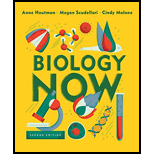
Concept explainers
The fossils refer any impression, conserved remains or trace of any living things from the previous geological age. Examples of fossils includes stone imprints of microbes or animals, bone, shells, and exoskeleton. The entirety of the fossils is termed as the fossil record. There are several types of fossils including index, transitional, trace, microfossils, chemical fossils, resin, and wood and sub fossils.
Answer to Problem 1TQ
The fossils that exhibits traits common to both ancestral and its descendant group are termed as intermediate fossils.
Therefore, option (c) is correct.
Explanation of Solution
Justify the reasons for the correct statement:
The intermediate fossils are otherwise called as transitional fossils. It is a fossilized residue of a life form. Intermediate fossils show the traits sharing similarities with their ancestral and descendant groups. It is essential where the group of descendant is severely distinguished from the group of ancestors by the mode of living and gross anatomy.
Option (c) is given as, “both of the above”.
Hence, the option (c) is correct.
Justify the reasons for the incorrect statements:
Option (a) is given as, “Share some similarities with their ancestral group”.
The transitional fossils not only share the similarities with their ancestral groups, but also shares similarities with their descendant groups. Hence, it is a wrong answer.
Option (b) is given as, “Share some similarities with their descendant groups”.
Intermediate fossils not only exhibits similarities with their descendant group, but also resembles their ancestral groups. Hence, it is a wrong answer.
Option (d) is given as, “none of the above”.
The given statement is not accurate because intermediate fossils shares similarities to both ancestral and descendant groups. Hence, it is a wrong answer.
Hence, options (a), (b), and (d) are incorrect.
Therefore, an intermediate fossils share some similarities with their ancestral groups and also shares some similarities with their descendant groups.
Want to see more full solutions like this?
- please draw in the answers, thank youarrow_forwarda. On this first grid, assume that the DNA and RNA templates are read left to right. DNA DNA mRNA codon tRNA anticodon polypeptide _strand strand C с A T G A U G C A TRP b. Now do this AGAIN assuming that the DNA and RNA templates are read right to left. DNA DNA strand strand C mRNA codon tRNA anticodon polypeptide 0 A T G A U G с A TRParrow_forwardplease answer all question below with the following answer choice, thank you!arrow_forward
- please draw in the answeres, thank youarrow_forwardA) What is being shown here?B) What is indicated by the RED arrow?C) What is indicated by the BLUE arrow?arrow_forwardPlease identify the curve shown below. What does this curve represent? Please identify A, B, C, D, and E (the orange oval). What is occurring in these regions?arrow_forward
- Please identify the test shown here. 1) What is the test? 2) What does the test indicate? How is it performed? What is CX? 3) Why might the test be performed in a clinical setting? GEN CZ CX CPZ PTZ CACarrow_forwardDetermine how much ATP would a cell produce when using fermentation of a 50 mM glucose solution?arrow_forwardDetermine how much ATP would a cell produce when using aerobic respiration of a 7 mM glucose solution?arrow_forward
 Human Anatomy & Physiology (11th Edition)BiologyISBN:9780134580999Author:Elaine N. Marieb, Katja N. HoehnPublisher:PEARSON
Human Anatomy & Physiology (11th Edition)BiologyISBN:9780134580999Author:Elaine N. Marieb, Katja N. HoehnPublisher:PEARSON Biology 2eBiologyISBN:9781947172517Author:Matthew Douglas, Jung Choi, Mary Ann ClarkPublisher:OpenStax
Biology 2eBiologyISBN:9781947172517Author:Matthew Douglas, Jung Choi, Mary Ann ClarkPublisher:OpenStax Anatomy & PhysiologyBiologyISBN:9781259398629Author:McKinley, Michael P., O'loughlin, Valerie Dean, Bidle, Theresa StouterPublisher:Mcgraw Hill Education,
Anatomy & PhysiologyBiologyISBN:9781259398629Author:McKinley, Michael P., O'loughlin, Valerie Dean, Bidle, Theresa StouterPublisher:Mcgraw Hill Education, Molecular Biology of the Cell (Sixth Edition)BiologyISBN:9780815344322Author:Bruce Alberts, Alexander D. Johnson, Julian Lewis, David Morgan, Martin Raff, Keith Roberts, Peter WalterPublisher:W. W. Norton & Company
Molecular Biology of the Cell (Sixth Edition)BiologyISBN:9780815344322Author:Bruce Alberts, Alexander D. Johnson, Julian Lewis, David Morgan, Martin Raff, Keith Roberts, Peter WalterPublisher:W. W. Norton & Company Laboratory Manual For Human Anatomy & PhysiologyBiologyISBN:9781260159363Author:Martin, Terry R., Prentice-craver, CynthiaPublisher:McGraw-Hill Publishing Co.
Laboratory Manual For Human Anatomy & PhysiologyBiologyISBN:9781260159363Author:Martin, Terry R., Prentice-craver, CynthiaPublisher:McGraw-Hill Publishing Co. Inquiry Into Life (16th Edition)BiologyISBN:9781260231700Author:Sylvia S. Mader, Michael WindelspechtPublisher:McGraw Hill Education
Inquiry Into Life (16th Edition)BiologyISBN:9781260231700Author:Sylvia S. Mader, Michael WindelspechtPublisher:McGraw Hill Education





